Zen gardens (Japanese: 枯山水 Karesansui), known as Karesansui in Japanese, are minimalist yet meaningful landscape compositions consisting of rocks, gravel, sand, and minimal vegetation, closely associated with Zen Buddhism in Japan. These gardens typically do not include water; instead, white gravel or sand is raked in wave-like patterns to represent rivers or ponds. The stones symbolize mountains, mosses represent islands, and the empty spaces reflect the infinity of nature.
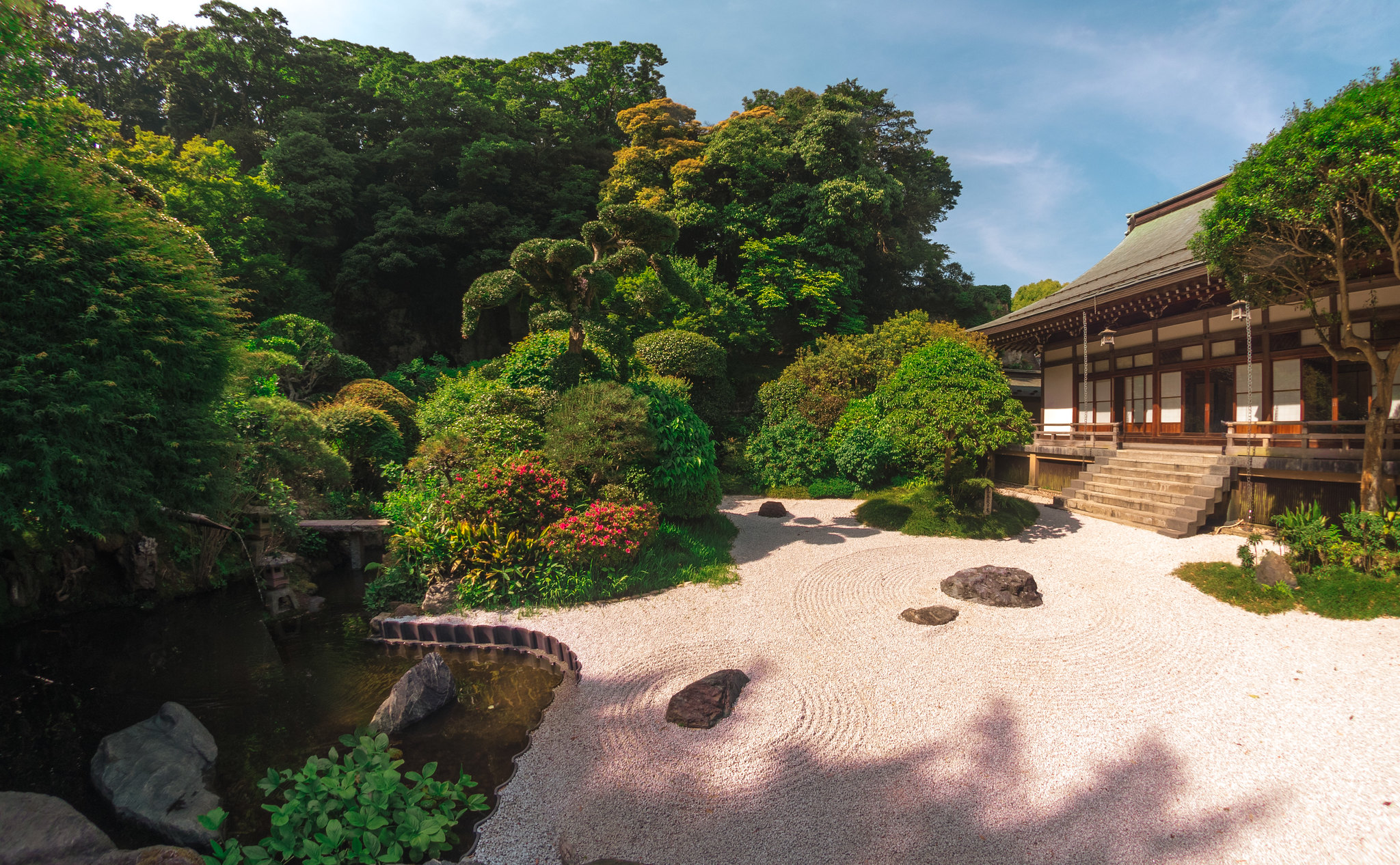
Kamakura Zen Garden (flickr)
History
The origins of Zen gardens are rooted in the aesthetic and philosophical traditions that evolved during the spread of Buddhism in Japan. Buddhist thought, which reached Japan in the 7th century during the reign of Prince Shōtoku, eventually developed into a distinct form known as Zen Buddhism. Zen gardens emerged as a spatial expression of this spiritual path.
One of the earliest written sources detailing the formal and theoretical development of Zen gardens is the Sakuteiki, a garden-making manual from the 11th century addressed to aristocratic circles. This text centers on the art of stone placement (ishi wo taten koto) and emphasizes that stones should be positioned “in accordance with their will.” The natural composition principles recommended in the Sakuteiki were influenced by the landscape aesthetics of China's Song Dynasty and the iwakura (sacred stones) tradition. In this context, stones are not merely decorative elements, but tools for connecting with nature and the divine.
Zen gardens took shape during the Kamakura (1185–1333) and Muromachi (1336–1573) periods, when Zen Buddhism gained significant social and cultural influence in Japan. During these eras, the influence of Chinese Ch’an (Zen) Buddhism increased, and garden design evolved alongside the architecture of Zen temples. Musō Soseki, a Zen monk, not only spread Zen teachings during this period but also built gardens that embodied these teachings in physical form. According to Soseki, meditation need not be confined to temple interiors; it can also occur in a space integrated with nature.【1】
Thus, he filled gardens with stones representing mountains, cliffs, and waterfalls, transforming them into miniature models of natural landscapes. This created a symbolic and experiential link between Zen practice and nature.
The Ōnin War (1467–1477) led to widespread destruction in Kyoto and the devastation of many temples. In the post-war period, economic constraints led to the rise of the karesansui (dry stone garden) style, which required fewer resources than large-scale water gardens. Gardens from this era became more abstract, more symbolic, and more suitable for meditation. Practical factors, such as water shortages, also influenced the preference for dry gardens.
From the 17th century onward, Zen gardens retained their traditional form but became less widespread. However, in the 20th century, they began to attract interest in the Western world. One of the earliest recorded uses of the term “Zen garden” appeared in 1935 in Loraine Kuck’s 100 Kyoto Gardens. Since the 1960s, dry stone gardens based on Japanese aesthetic principles have been built in cities such as Portland, Montreal, and Boston. However, these Western interpretations were often more visual and representational than their Japanese counterparts.
Today, Zen gardens are not only part of Buddhist temples but also found in museums, city parks, therapy centers, and private homes. They are now increasingly associated with modern concepts such as spiritual calmness, introspection, and mindfulness rather than aesthetics alone.
Philosophical Foundations
Zen gardens are intellectual spaces that reflect the ontological and epistemological principles of Zen Buddhism. These gardens reveal the relationship between humans and nature through a simple, symbolic, and intuitive language. Prominent design elements such as emptiness, silence, asymmetrical balance, naturalness, and impermanence are directly connected to core concepts of Zen philosophy.
Zen Buddhism, which originated in the 6th century in China’s Ch’an school, gained prominence in Japan during the Kamakura period in the 12th century. The teaching holds that enlightenment (satori) can be attained not solely through intellectual knowledge, but through direct experience. Therefore, the practice of meditation (zazen) is central. Zen gardens developed alongside this practice, designed to support meditation. Musō Soseki believed that a personal connection with nature aided the individual’s journey to enlightenment and described nature as “a guide to spiritual development.” According to Soseki, a cultivated mind can internalize and unite with nature, turning even the ordinary environment into a space for enlightenment.【2】
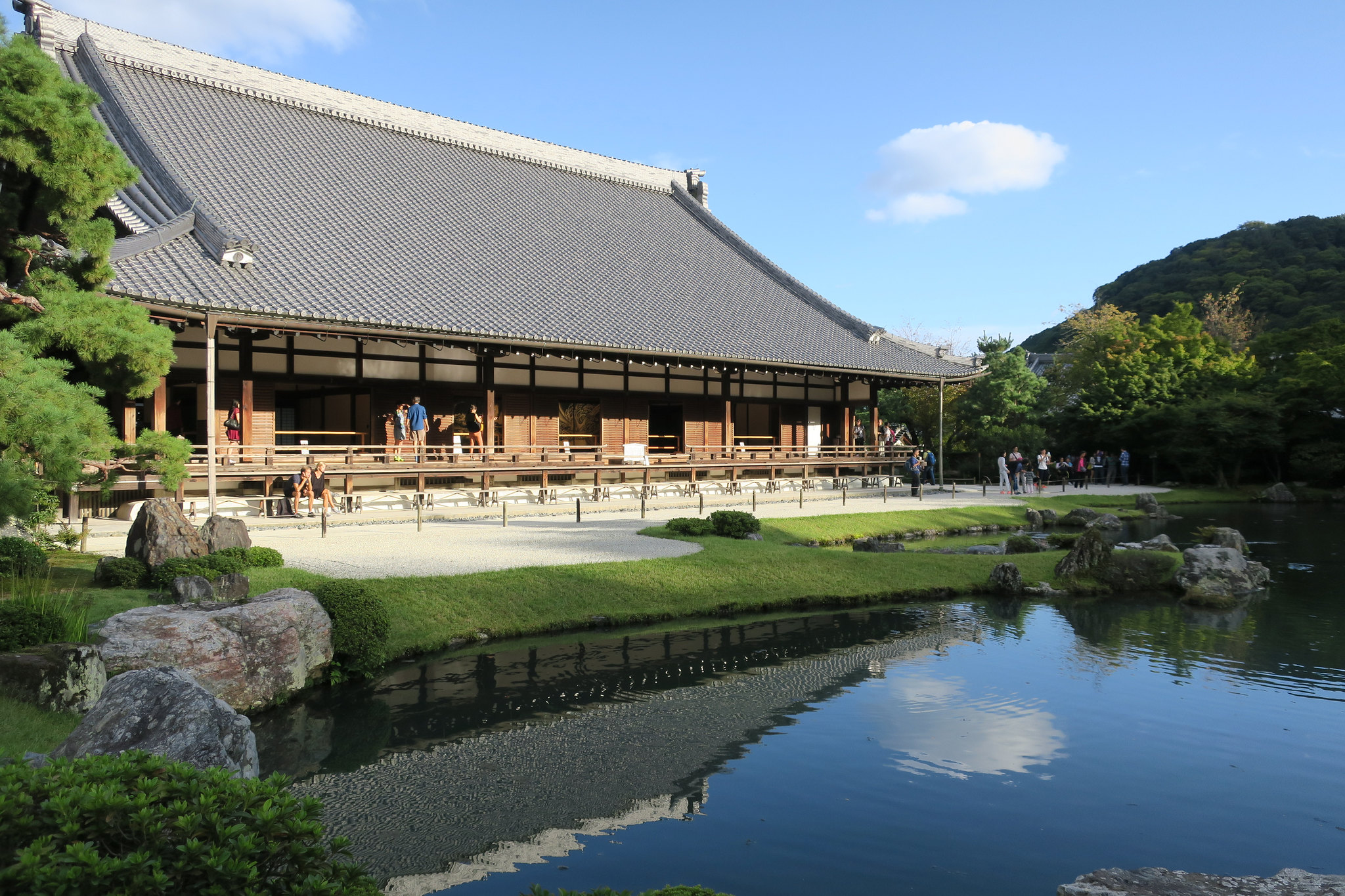
Zen Garden Designed by Musō Soseki (flickr)
Zen thought does not view nature as an absolute standard of beauty but as a collection of metaphors that convey teachings. Elements like stones, gravel, and moss symbolize certain natural forms, but these representations do not carry fixed or universal meanings. The gardens are open structures that allow each individual to construct meaning through personal experience.
Zen philosophy also emphasizes the overcoming of dualities. In this context, contrasts such as full-empty, order-chaos, motion-stillness—seen in Zen gardens—invite the viewer to intuitively sense the idea of unity through awareness.
Another philosophical influence in the construction of Zen gardens is Shintō animism. According to this belief, natural elements such as stones, trees, and streams possess living spirits. Sacred stones known as iwakura are considered the dwelling places of deities. The Sakuteiki’s instruction that one must “listen to the will of the stone” (ishi no kowan ni shitagahite) reflects this animistic understanding embedded in the design process.
Symbolic Meanings
Each element in Zen gardens (stones, gravel, moss, void, and even the layout itself) represents a symbolic domain. However, these symbols are not fixed, universal, or dogmatic; in keeping with Zen thought, they are multilayered, open to interpretation, and based on intuition.
Stones: Mountains, Cliffs, Wisdom, and the Mind
Stones are the most fundamental structural element of Zen gardens and often symbolize natural or mythological elements such as mountains, cliffs, islands, tigers, cranes, or the rocky seats of sages. In Musō Soseki’s gardens, stones were arranged as miniature representations of Japanese landscapes, allowing spiritual vastness to be recreated on a human scale.
Sand and Gravel: Water, Emptiness, Silence
Zen gardens usually do not contain actual water; instead, white sand or gravel is used to represent it. This material stands for various forms of water (e.g., lakes, oceans, rivers, or waterfalls). The wave-like patterns raked into the gravel mimic the ripples on the surface of water. This technique is based on making the presence of water felt without its physical presence. Gravel and sand also symbolize silence, purification, emptiness, and clarity of mind—key concepts in Zen.
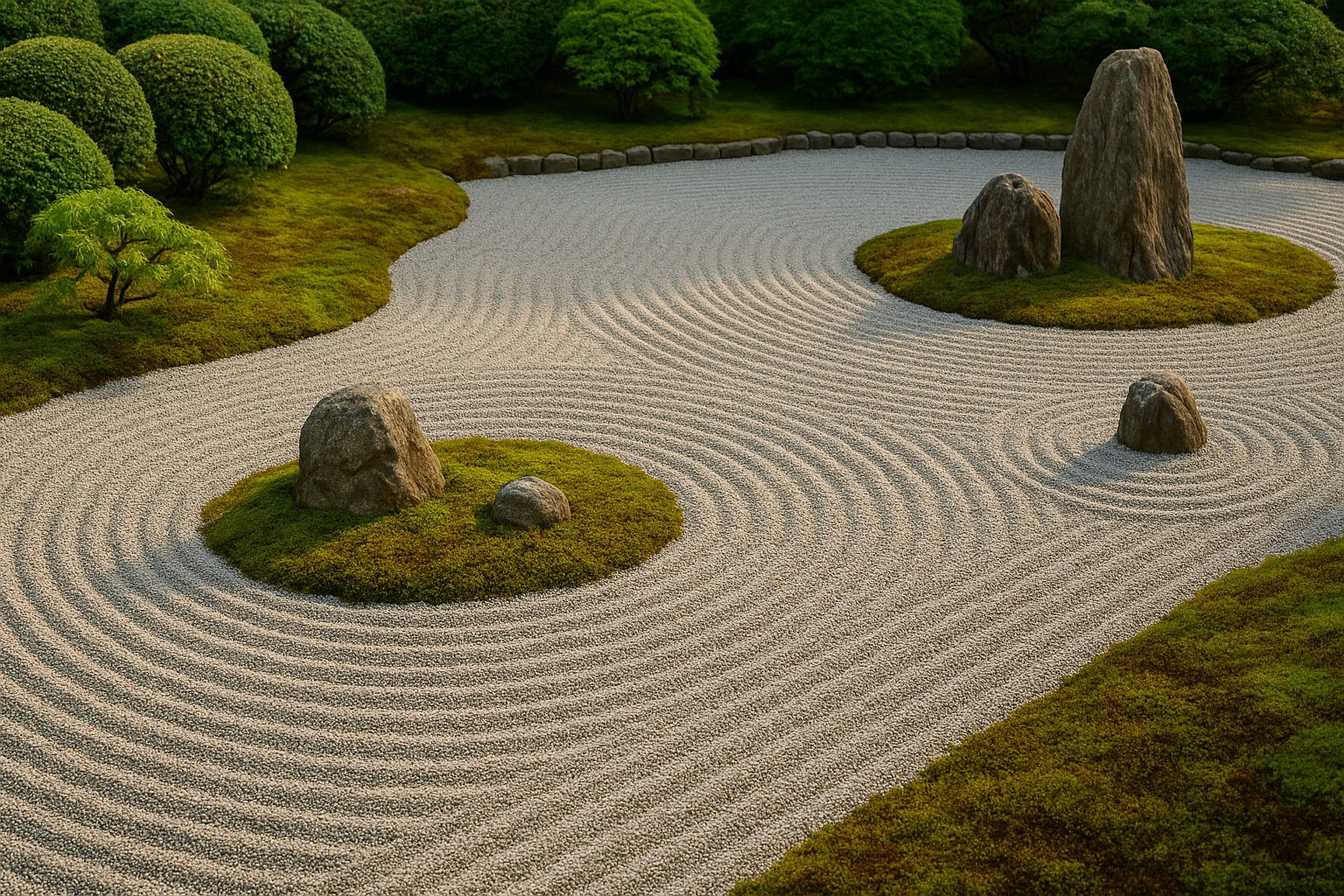
Example of Stone and Sand (AI-Generated)
Moss: Islands, Continuity, and Time
Moss is used sparingly but strategically in Zen gardens, often surrounding stone groupings to represent islands. Its steady growth, loyalty to the soil, and slow pace give the impression of nature’s slowness, continuity, and accumulated history. This aesthetic aligns with the wabi-sabi concept of appreciating imperfection and impermanence.
Emptiness (Ma): Potential and Awareness
Emptiness in Zen gardens is not merely “the absence of something” but an active, meaningful component. Known as ma in Japanese aesthetic thought, emptiness is seen as a space for stillness, potential, and transience. It is as essential as the presence of stones and gravel. In examples like Ryōan-ji, wide open spaces between stone groupings encourage the viewer to seek meaning in emptiness and become aware of it within their own mind.
Numerical and Formal Symbols
Stones are typically arranged in odd-numbered groups (e.g., 2, 3, 5). In Japanese culture, odd numbers represent natural asymmetry, while even numbers symbolize artificiality and symmetry. Asymmetry is considered a reflection of the irregularity and authenticity found in nature. These choices reflect Zen philosophy’s appreciation of fluidity and incompleteness over rigid order.
The Garden as a Whole
Some Zen gardens are based on mythological or historical narratives. In certain gardens, for instance, stones are arranged to represent a crane and its offspring, a dragon, or a philosopher's journey toward enlightenment. However, these representations are not explicitly depicted; the narrative is constructed through the viewer’s intuitive experience.
Notable Examples
Zen gardens have been designed in various styles and for different purposes throughout history, both in Japan and globally. However, some examples stand out due to their historical continuity, symbolic richness, or cultural influence.
Ryōan-ji Temple Garden (Kyoto, 15th century)
The dry stone (karesansui) garden of Ryōan-ji is arranged in a rectangular area of approximately 248 m², with 15 stones placed in five groupings. No single viewpoint reveals all the stones at once. The surrounding gravel is meticulously raked into linear and circular patterns to symbolize water movement.
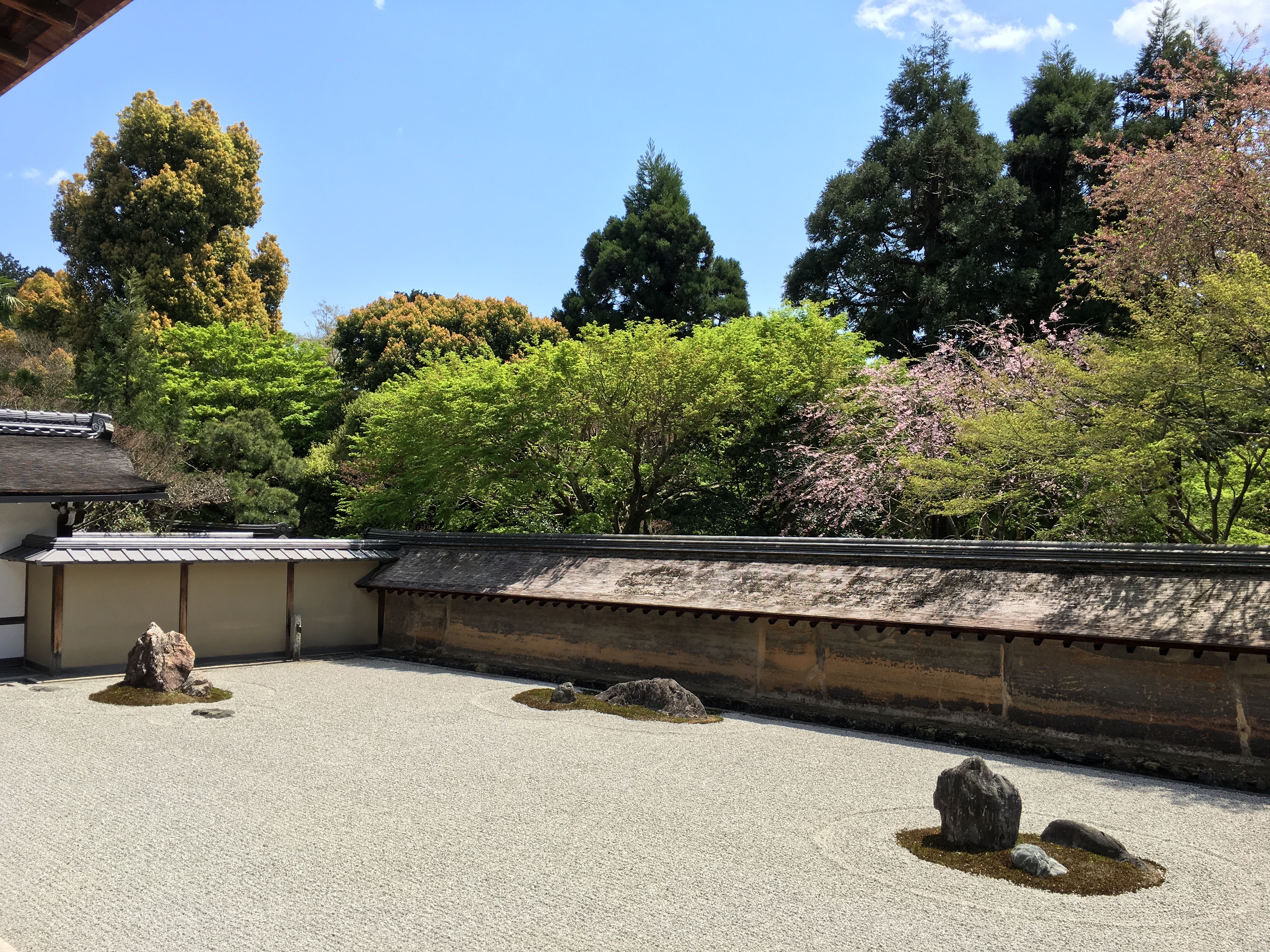
Ryōan-ji (flickr)
Daitoku-ji Temple (Kyoto)
The Daitoku-ji temple complex in Kyoto includes several sub-temples of the Rinzai school of Zen Buddhism, each with its own karesansui garden. Notably, the garden at the Daisen-in sub-temple is designed around a metaphor of a life journey from birth to death. Stones are arranged to resemble a stream flowing from small to large formations. Though water is absent, the gravel represents its flow.
Tōfuku-ji Temple (Kyoto, 1939)
The modern karesansui gardens of Tōfuku-ji were designed in the 20th century by landscape architect Shigemori Mirei. While preserving traditional Zen garden forms, Shigemori incorporated modern abstraction and graphic composition principles. The four surrounding gardens each express different thematic interpretations—for example, the northern garden features a grid-like layout made with stones.
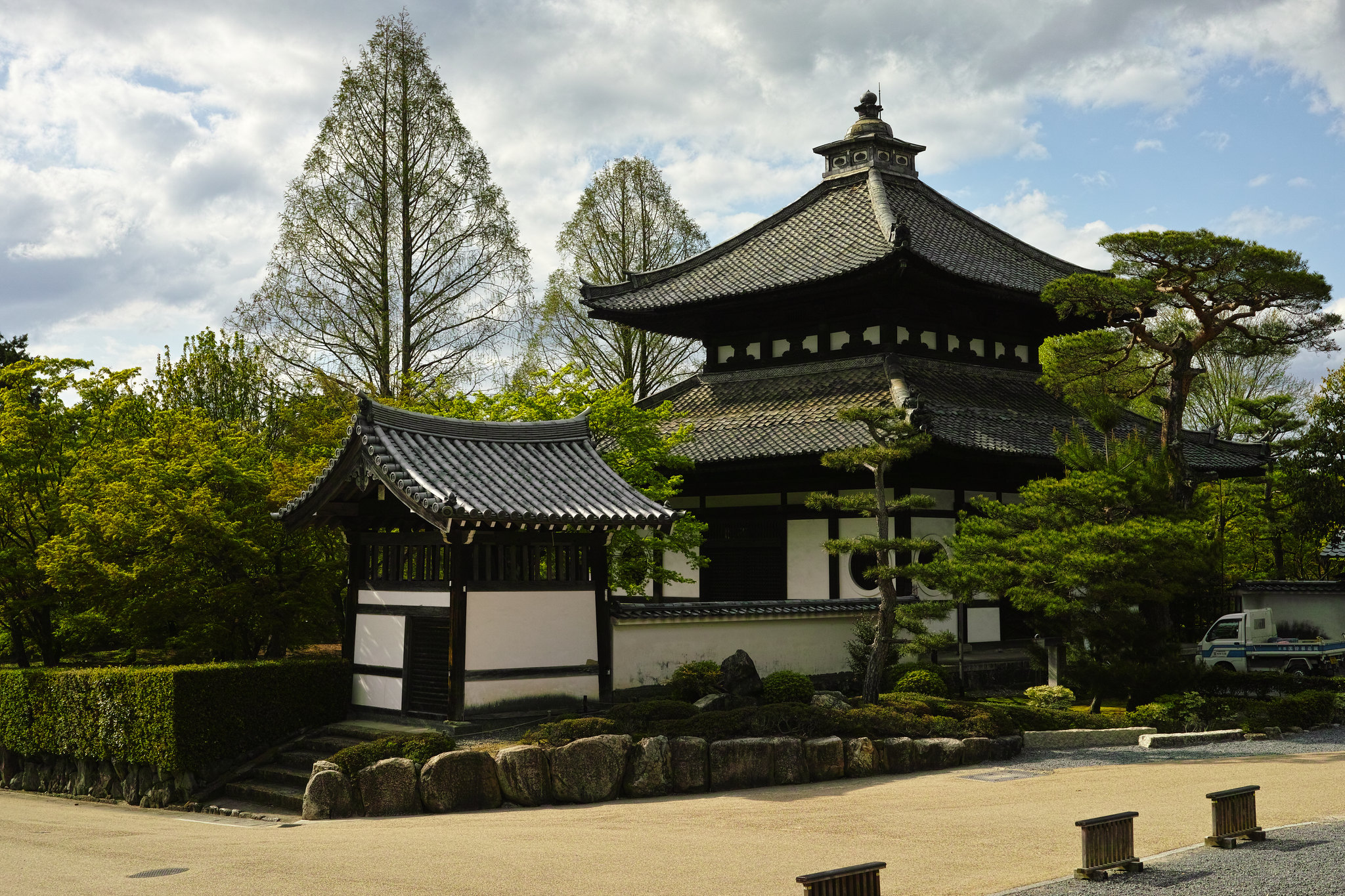
Tōfuku-ji (flickr)
Portland Japanese Garden – Sand and Stone Garden (USA, 1961)
One of the first significant Zen garden examples built in the West, this garden is located within the Portland Japanese Garden. Though based on traditional Japanese models, its design emphasizes visual symmetry and harmony more clearly, helping Western audiences better grasp Zen aesthetics.
Roji-en – Morikami Japanese Gardens (Florida, USA, 2001)
Roji-en is part of a large complex that incorporates six different Japanese garden styles. The dry stone garden within this complex merges traditional Zen principles with modern landscape design. Designed specifically for meditation and mindfulness, the garden features raked sand patterns intentionally directed to create focal points, with wide open spaces around stone groupings.


